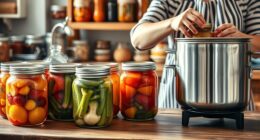To can safely at home, start with clean, sterilized jars and lids, choosing high-quality produce. Pack jars carefully to avoid air pockets, leaving proper headspace, and wipe rims before sealing. Use the right method: water bath canning for high-acid foods or pressure canning for low-acid items, following recommended times. After processing, check seals and store jars in a cool, dark place. Once you understand these essential steps, you’ll gain confidence in preserving your food safely and effectively.
Key Takeaways
- Use high-quality, fresh produce and follow trusted recipes with proper processing times.
- Sterilize jars and lids by boiling to prevent contamination and spoilage.
- Pack jars carefully, leaving appropriate headspace and wiping rims before sealing.
- Choose the correct canning method—water bath for high-acid foods, pressure canning for low-acid foods.
- Cool jars naturally, check seals, label, and store in a cool, dark place for safe preservation.

Canning can seem overwhelming at first, but with the right knowledge, it becomes straightforward and enjoyable. The key is understanding the basic steps and safety guidelines so you can preserve food confidently. Start by gathering all your supplies: clean jars with lids, a large pot or canner, a jar lifter, a funnel, and a clean cloth. Make sure everything is sterilized before you begin—wash your jars and lids in hot, soapy water, then boil them for at least 10 minutes to eliminate bacteria and other contaminants.
Next, choose quality ingredients. Fresh, ripe produce yields the best results and reduces the risk of spoilage. When preparing your food, follow trusted recipes that specify processing times and pressure or water bath canning methods. Proper preparation is essential; for example, cut fruits and vegetables evenly, and remove any bruised or damaged parts. Pack your jars carefully, leaving the recommended headspace—usually about ¼ inch—to allow for expansion during processing.
Choose fresh, ripe produce and follow trusted recipes for safe, high-quality canning results.
The canning process itself depends on what you’re preserving. For high-acid foods like fruits, jams, and pickles, water bath canning works well. You simply place the filled jars into a boiling water bath, making sure they’re fully submerged by at least an inch of water. For low-acid foods like vegetables, meats, and soups, pressure canning is necessary to reach the high temperatures needed to kill bacteria like botulism spores. Follow your pressure canner’s instructions meticulously, adjusting for altitude if necessary, to guarantee proper processing pressure and time.
Once your jars are processed, carefully remove them from the canner using a jar lifter, and set them on a clean towel or cooling rack. Don’t tighten the lids immediately—allow the jars to cool naturally. As they cool, you’ll hear a satisfying pop as the lids seal. Check each jar to ensure the lid is concave and sealed properly; any jars that haven’t sealed should be refrigerated and used promptly or reprocessed with a new lid.
Label your jars with the date and contents so you can keep track of freshness. Store them in a cool, dark, and dry place to maximize shelf life. With practice, you’ll gain confidence and develop your own techniques, making home canning a dependable way to enjoy preserved foods. Remember, safety is paramount—never skip steps or ignore signs of spoilage. Once you master these basics, canning becomes an empowering skill that preserves your harvest and saves money, all while providing you with delicious, homemade foods year-round.
Frequently Asked Questions
Can I Can Low-Acid Foods Without Special Equipment?
No, you can’t safely can low-acid foods without special equipment. Low-acid foods like vegetables and meats need a pressure canner to reach the necessary high temperatures to kill harmful bacteria and spores. Using just water bath canning jars or other equipment isn’t safe because it doesn’t attain the required heat. Always use a proper pressure canner for low-acid foods to ensure your preserved products are safe to eat.
How Long Can Canned Goods Be Stored Safely?
Your canned goods can be your pantry’s timeless treasures, lasting up to a year or more if stored properly. Keep them in a cool, dark, and dry place, away from sunlight and temperature fluctuations. If the jars remain sealed and the contents look, smell, and taste normal, they’re safe to enjoy. But always check for signs of spoilage before opening, ensuring that your home-preserved bounty remains a safe, delicious companion.
Are There Vegetarian or Vegan Canning Options?
Yes, there are vegetarian and vegan canning options. You can preserve vegetables, fruits, beans, and plant-based sauces like tomato or vegetable-based salsas. Use plant-based ingredients and avoid animal products like gelatin or dairy. When canning, guarantee you follow proper safety guidelines to prevent spoilage. With the right techniques, you can enjoy a variety of delicious, plant-based preserved foods all year round, keeping your diet vibrant and cruelty-free.
What Are Common Signs of Spoilage in Canned Foods?
Think of your canned foods like silent guardians—if they show a bulging lid, it’s a red flag, signaling danger. Look for leaks, foul odors, or discoloration, which are like alarm bells warning you to discard the jar. Any fizzing or bubbling when opening indicates fermentation. Trust your senses; if something feels off, it’s best to let it go. Your safety depends on recognizing these subtle signals.
Can I Reuse Canning Jars and Lids Safely?
Yes, you can reuse canning jars and lids safely if you follow proper procedures. Inspect jars for cracks, chips, or cloudiness, and discard any damaged ones. Clean jars thoroughly with hot, soapy water and boil lids for sterilization. However, lids with a rubber seal should be replaced each time, as they lose their sealing ability. Always verify a proper seal before storing your canned goods.
Conclusion
As you seal each jar, you’re locking in more than just food—you’re preserving tradition, safety, and peace of mind. Think of your canned goods as tiny safekeeping vaults, guarding your family’s well-being through the seasons. With every careful step, you’re nurturing a legacy of self-reliance. When you open those jars later, it’s not just a meal; it’s a symbol of your dedication and care—transforming simple preservation into a lasting act of love.










